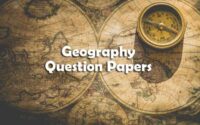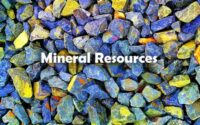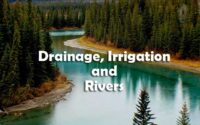BPSC Geography Questions and Answers
BPSC Geography Questions paper pdf for examination is given below. Bihar Public Service Commission geography question papers direct download links are given in this section. Hence, download the BPSC Geography Previous Paper pdf below.

Bihar Public Service Commission Geography Previous Papers Pdf help the applicants in their preparation. BPSC Geography previous papers are available here to download. This is the good news for the candidates who are preparing for Bihar Public Service Commission.
Aspirants can download Bihar Public Service Commission Model Papers on Geography pdf through online mode. Applicants who are preparing for Bihar Public Service Commission written exam can download BPSC Geography Sample questions from our website for free.
Questions and Answers on Geography for BPSC
1. The semi-plastic layer below the crust is called as
(A) Exosphere
(B) Aesthenosphere
(C) Plagioclase
(D) Pyroclastic layer
2. The material found in the rift valleys is from
(A) Aesthenosphere
(B) Core
(C) Continental crust
(D) Upper crust
3. The average density of the earth’s core is
(A) 12g cm-3
(B) 11 g cm-3
(C) 5.5 g cm-3
(D) 2.6 g cm-3
4. The earth was believed to be originated by accretion and aggregation of solid dust particles known as
(A) Planetesimals
(B) Mountains
(C) Crust
(D) Molten layer
5. The dominant chemical constituents in ‘Sima’
(A) Silica and magnesium
(B) Silica and manganese
(C) Silica and ferrium
(D) Silica and aluminium
6. According to Daly how many layers are present in the interior of the earth ?
(A) 3
(B) 4
(C) 5
(D) 2
7. Which of the following is an example for diastrophic force?
(A) Orogenesis
(B) Landslides
(C) Soil creep
(D) Mudflow
8. Which of the following is an example for epeirogenetic movement?
(A) Subsidence
(B) Landslide
(C) Soil creep
(D) Mudflow
9. The process of collision of oceanic and continental plates is known as
(A) Divergence
(B) Subduction
(C) Convergence
(D) transformation
10. The divergent plate boundary is also known as
(A) Subduction zone
(B) Spreading centre
(C) Collision zone
(D) Elastic zone
11. The rift valley of East Africa is an example for
(A) Convergent margin
(B) Divergent margin
(C) Collision zone
(D) Submergence zone
12. The point of the occurrence of an earthquake is called
(A) Epicentre
(B) Focus
(C) Tremor
(D) Main tremor
13. Secondary seismic waves are also known as
(A) Compressional waves
(B) Longitudinal waves
(C) Transverse waves
(D) Surface waves
14. Conservative plate margins are also known as
(A) Shear plate margins
(B) Consuming plate margins
(C) Accreting plate margins
(D) Parallel fault boundaries
15. The other name for the zone of collision of convergent plates
(A) Benioff zone
(B) Obduction zone
(C) Shear zone
(D) Accretion zone
16. Isochrons are the lines which join points of equal
(A) Dates of humidity
(B) Dates of magnetic stripes
(C) Dates of rainfall
(D) Dates of temperature
17. The volcanic lava occur along the constructive plate margins is called
(A) Tholeiite
(B) Aa aa lava
(C) Tephra
(D) Phreatic lava
18. ‘Mid-Continental Belt’ is also known as
(A) The volcanic zones of convergent continental plate margins
(B) The volcanic zones of divergent continental plate margins
(C) The volcanic zones of parallel plate margins
(D) The volcanic zones of transform plate margins
19. Volcanic neck is also known as
(A) Plug dome
(B) Diatreme
(C) Parasite cone
(D) Caldera
20. The volcanic cones formed due to accumulation of different layers of volcanic materials are known as
(A) Ant mount
(B) Strato-cones
(C) Plug dome
(D) Craterlets
| RRB NTPC | AFCAT |
| TNPSC | SSC CHSL |
| MPSC | SSC CGL |
| UPSC | WBCS |
| CDS | BPSC |
21. The active volcano in the Mediterranean sea is
(A) Strombolian
(B) Visuvious
(C) Peleean
(D) Fissure
22. The process of change of feldspar minerals into kaolinite clays is called
(A) Chelation
(B) Oxidation
(C) Hydration
(D) Carbonation
23. Which of the following is an example for very rapid mass movement?
(A) Slump
(B) Soil creep
(C) Rock creep
(D) Solifluction
24. Who proposed slope decline theory?
(A) R.A.Savigear
(B) W.M.Davis
(C) W.Penck
(D) A.W.Wood
25. Whose slope model reveals that the mechanism of surface process is affected and controlled by the properties of forms?
(A) W.M.Davis
(B) A.W.Wood
(C) W.Penck
(D) R.A.Savigear
26. The upward movement of base level leads to formation of
(A) Ria coasts
(B) Waterfalls
(C) Canyons
(D) Cascades
27. Which one of following is a depositional landform?
(A) Structural bench
(B) Natural levee
(C) River terrace
(D) River meander
28. In glacial areas the higher peaks and mounds are surrounded by ice from all sides are called
(A) Tarn
(B) Nunatak
(C) Crag and tail
(D) Moraines
29. Which of the following is a depositional landform of glacial topography?
(A) Nunatak
(B) Horn
(C) Drumlins
(D) Tarn
30. Insebergs are also called
(A) Bornhardts
(B) Yardangs
(C) Cockscomb
(D) Ergs
31. Dunes formed in deserts due to the presence of obstacles of shrubs are called
(A) Dune chain
(B) Nebkhas
(C) Dune colony
(D) Inselbergs
32. A bar connecting two headlands is called
(A) Island
(B) Tombolo
(C) Hook
(D) Bar
33. Beach ridges are also known as
(A) Beach cusps
(B) Berms
(C) Barriers
(D) Offshore bars
34. Pinnacles are found in
(A) Coastal areas
(B) Glaciers
(C) Deserts
(D) Limestone areas
35. The mobile sands in deserts are called
(A) Inselbergs
(B) Ergs
(C) Buffalo wallows
(D) Yardangs
36. According to Pettersen which of the following is the third layer in the atmosphere from the earth’s surface?
(A) Troposphere
(B) Exosphere
(C) Stratosphere
(D) Ozonosphere
37. The Pettersen’s atmospheric composition is mainly based on
(A) Humidity
(B) Temperature
(C) Precipitation
(D) Wind speed
38. Which layer of the atmosphere is called Convective region?
(A) Stratosphere
(B) Troposphere
(C) Exopsphere
(D) Ionosphere
39. The other name for Ozonosphere is
(A) Exosphere
(B) Troposphere
(C) Mesosphere
(D) Stratosphere
40. G layer is found in
(A) Mesosphere
(B) Ionosphere
(C) Exosphere
(D) Stratosphere
41. Which of the following factors affects the distribution of insolation?
(A) Transparency of atmosphere
(B) Vegetation
(C) Soils
(D) Water bodies
42. According to Kendrew, about 43% of the insolation is received through
(A) Longer infra-red waves
(B) Ultraviolet waves
(C) Shorter gamma waves
(D) Longer micro-waves
43. The total solar radiation reflected back to space is about
(A) 10 units
(B) 7 units
(C) 12 units
(D) 9 units
44. The solar radiation reflected back to the space is due to
(A) Air and fine dust
(B) Thick green vegetation
(C) Light coloured soils
(D) Land-sea surfaces
45. Diffusion of solar radiation occurs when the particle size is
(A) Larger than wave length of light
(B) Smaller than wave length of light
(C) Very smaller than wave length of light
(D) None of these
46. The size of the freezing nucleus in the atmosphere is about
(A) 1 micrometer
(B) 5 micrometers
(C) 4 micrometers
(D) 6 micrometers
47. Who propounded the theory of collision- coalescence of formation of precipitation?
(A) TorBergerson
(B) Talor
(C) E.G.Boven
(D) Charles B.Moore
48. The size of the water drops in drizzle is
(A) Less than 5 mm
(B) Between 5 mm and 6.5 mm
(C) Exactly 6.5 mm
(D) Between 6.25mm and 6.65mm
49. Which type of precipitation is associated with the salient feature of inversion of rainfall?
(A) Convectional
(B) Cyclonic
(C) Orographic
(D) Both convectional and cyclonic
50. The direction of circulation of low pressure in a cyclone in northern hemisphere is
(A) Anticlockwise
(B) Clockwise
(C) Both clockwise and anticlockwise
(D) None of these



